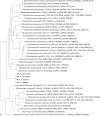Genomic analysis reveals the presence of a class D beta-lactamase with broad substrate specificity in animal bite associated Capnocytophaga species
- PMID: 27909820
- PMCID: PMC5366173
- DOI: 10.1007/s10096-016-2842-2
Genomic analysis reveals the presence of a class D beta-lactamase with broad substrate specificity in animal bite associated Capnocytophaga species
Abstract
Capnocytophga canimorsus and Capnocytophga cynodegmi can be transmitted from cats and dogs to humans, and can cause a wide range of infections including wound infections, sepsis, or endocarditis. We and others recently discovered two new Capnocytophaga species, C. canis and C. stomatis, mainly associated with wound infections. The first-line treatment of animal bite related infections is penicillin, and in case of allergy, doxycycline and trimethoprim/sulfamethoxazole. However, there is a lack of antibiotic susceptibility patterns for animal bite associated Capnocytophaga species. Thus, we set out to study the antibiotic profiles against animal bite associated Capnocytophaga species isolated from wound and blood cultures after cat and dog bites and coupled the findings to whole genome sequencing data. A total of 24 strains were included in the study. Phenotypic analysis of antibiotic resistance was performed with E-tests. The web-based tool 'Resfinder' was used to identify resistance genes in the whole genome dataset. Two strains of C. cynodegmi and two strains of the recently discovered C. stomatis were resistant to penicillin (MIC > 24 mg/L) and cephalosporins (MIC > 24 mg/L), and three out of these strains also exhibited resistance to imipenem (MIC = 32 mg/L). Genomic analysis revealed that these strains carried a class D beta-lactamase gene, which has not previously been found in Capnocytophaga spp. A class D beta lactamase with broad substrate specificity was found in animal bite associated Capnocytophaga species, which could have important implications when treating wound infections after cat and dog bites. It also suggests that pet animal bacteria can harbour resistance genes with relevance for human infections.
Conflict of interest statement
Funding
These studies were supported by grants from the Swedish Research Council (PB) and Karolinska Institutet.
Conflict of interest
There is no conflict of interest.
Ethical approval
This study only involves bacterial isolates, which are exempted from ethical approval in Sweden.
Informed consent
Not applicable, since the study only involves bacterial isolates.
Figures
Similar articles
-
Investigation of antimicrobial susceptibility and resistance gene prevalence in Capnocytophaga spp. isolated from dogs and cats and characterization of novel class A β-lactamase CST-1.Eur J Clin Microbiol Infect Dis. 2025 Mar;44(3):559-569. doi: 10.1007/s10096-024-05025-0. Epub 2024 Dec 20. Eur J Clin Microbiol Infect Dis. 2025. PMID: 39707108
-
Whole genome sequencing identifies a novel species of the genus Capnocytophaga isolated from dog and cat bite wounds in humans.Sci Rep. 2016 Mar 7;6:22919. doi: 10.1038/srep22919. Sci Rep. 2016. PMID: 26947740 Free PMC article.
-
Characterization of three strains of Capnocytophaga canis isolated from patients with sepsis.Microbiol Immunol. 2018 Sep;62(9):567-573. doi: 10.1111/1348-0421.12642. Microbiol Immunol. 2018. PMID: 30118139
-
[Capnocytophaga canimorsus infections: a possibly fatal complication of bite wounds].Tijdschr Diergeneeskd. 1999 Feb 15;124(4):108-10. Tijdschr Diergeneeskd. 1999. PMID: 10081807 Review. Dutch.
-
[Bite-associated bacterial wound infections in humans].Mikrobiyol Bul. 2004 Oct;38(4):471-85. Mikrobiyol Bul. 2004. PMID: 15700676 Review. Turkish.
Cited by
-
Bilateral acute renal cortical necrosis after a dog bite: case report.BMC Infect Dis. 2021 Feb 27;21(1):231. doi: 10.1186/s12879-021-05901-6. BMC Infect Dis. 2021. PMID: 33639872 Free PMC article.
-
A case report of Capnocytophaga canimorsus meningitis with failure of ceftriaxone therapy.J Assoc Med Microbiol Infect Dis Can. 2024 Mar 29;9(1):46-51. doi: 10.3138/jammi-2023-0003. eCollection 2024 Mar. J Assoc Med Microbiol Infect Dis Can. 2024. PMID: 38567365 Free PMC article.
-
Regional antimicrobial resistance gene flow among the One Health sectors in China.Microbiome. 2025 Jan 7;13(1):3. doi: 10.1186/s40168-024-01983-x. Microbiome. 2025. PMID: 39763003 Free PMC article.
-
The Brief Case: Capnocytophaga sputigena Bacteremia in a 94-Year-Old Male with Type 2 Diabetes Mellitus, Pancytopenia, and Bronchopneumonia.J Clin Microbiol. 2021 Jun 18;59(7):e0247220. doi: 10.1128/JCM.02472-20. Epub 2021 Jun 18. J Clin Microbiol. 2021. PMID: 34142857 Free PMC article. No abstract available.
-
A metagenomic glimpse into the gut of wild and domestic animals: Quantification of antimicrobial resistance and more.PLoS One. 2020 Dec 3;15(12):e0242987. doi: 10.1371/journal.pone.0242987. eCollection 2020. PLoS One. 2020. PMID: 33270717 Free PMC article.
References
MeSH terms
Substances
LinkOut - more resources
Full Text Sources
Other Literature Sources
Medical
Molecular Biology Databases
Miscellaneous


